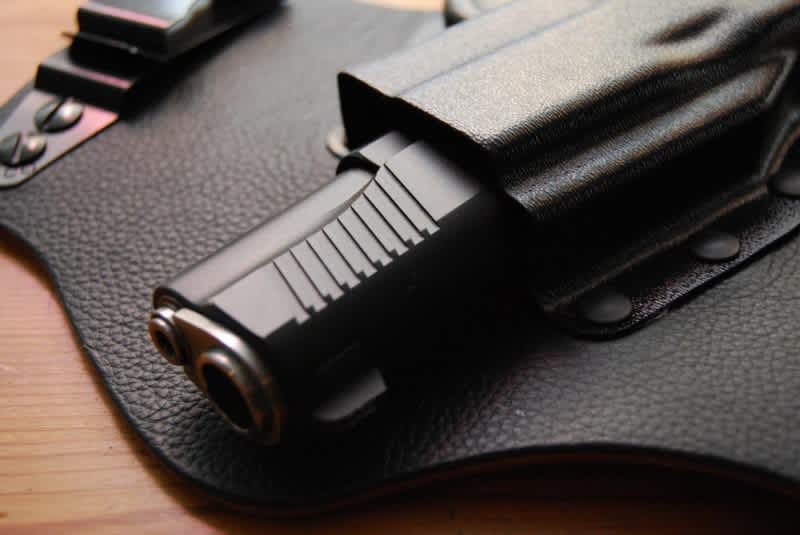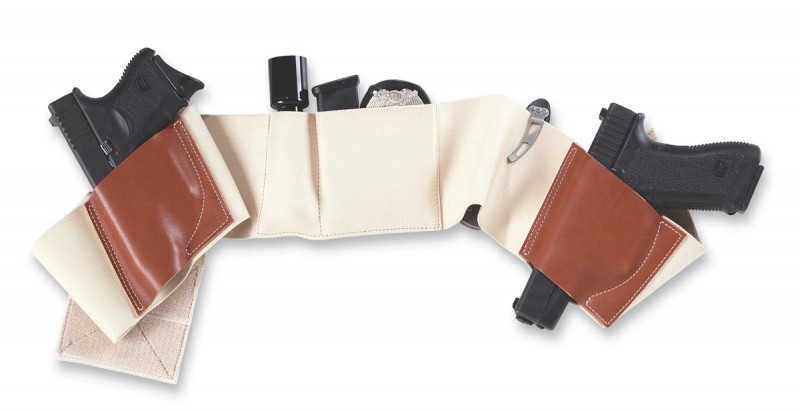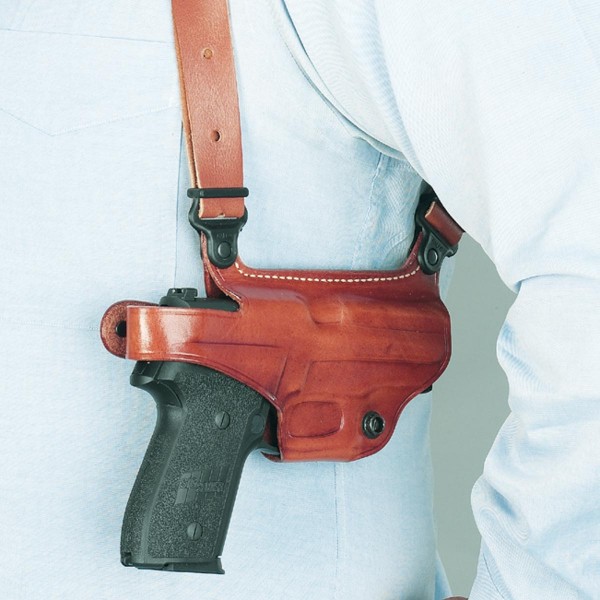The 5 Best Nontraditional Concealed Carry Methods
Tom McHale 02.25.15

When you stop and think about it, all forms of concealed carry represent a compromise. Unless you’re stumbling through life carrying your gun at eye level, like characters on The Walking Dead, you’re always going to have to sacrifice some degree of speed, concealment, and/or gun security with any carry method.
Let’s be clear about the carry methods discussed here. If you subscribe to the popular assumption that belt carry is the most accessible way to carry a gun, by definition, all of the methods discussed here are even more of a compromise. I get it. Belt carry is the best and only way to carry a gun. Any other methods are (fill in the blank): irresponsible, stupid, wrong, ridiculous, impractical, the worst idea ever, and/or will cause massive outbreaks of bunions. But seriously, as handy and accessible as belt carry can be, there are simply times and situations in which it isn’t an option. Some environments and situations require a little creativity.
For example, if you spend your day driving, a traditional IWB (inside the waistband) or OWB (outside the waistband) belt holster is less than ideal. A cross-draw setup works better in the car, but not as well once you get out because you have to cover it. Perhaps your work environment requires a neat and tidy tucked-in shirt. Perhaps you wear a dress every day. Maybe you spend your days in a place that requires ultra-deep concealment. Perhaps your employer isn’t as concerned with your protection as you are. There are a million reasons that you might need to resort to concealed carry tradeoffs.
Let’s explore a few, keeping in mind the three functions of a good gun holster:
- Allows quick and safe access to your gun
- Protects the trigger
- Ensures your gun remains under your control
1. Undershirt holster
In the early days, I had an embarrassing experience with a spandex undershirt holster. It was a model with padded pockets placed well below the armpit and angled toward the front. A small single patch of velcro kept the gun in the pocket. To make a long story short, I bent over to pick up something from the ground and a Glock 32 launched through my shirt collar, landing on the ground about six feet in front of me. Fortunately, designs have been dramatically improved since then and two “styles” stand out as solid performers.
5.11 Tactical makes a concealed carry undershirt with padded pockets on both sides. Two Velcro sections keep the pocket closed, thereby containing your gun and spare magazines carried on the opposite side. Be sure to use a gun small enough so that it doesn’t apply pressure to the Velcro closures or gun security will suffer.
Undertech Undercover takes a slightly different approach. The gun pocket is elastic and placed up high. Your underarm applies downward pressure on the grip, thereby keeping things secure. There’s also a strap, but I’m less enthusiastic about that as it’s one more thing to fumble with when you’re already reaching into your shirt. It’s slightly slower to access than the 5.11 approach, but gun security is better.
The biggest advantage of this carry method is fantastic concealment. The biggest disadvantage is quickly accessing the gun. You’ll have to move your outer shirt up and out of the way, or open a buttoned shirt to get to your firearm. Don’t count on being able to rip buttons off like in the movies, you’ll want to replace the middle-area buttons with Velcro tabs and “fake” buttons for your outer shirt. Oh, one more thing: use discretion when hugging others.
By the way, there are styles and fits for men and women, so it’s an equal-opportunity carry method.
2. Bellyband
Bellybands make the list for top unconventional carry methods because of their flexibility. You can wear it around your belly, of course. You can also wear it lower around your hips and it becomes the ultimate concealed tuckable holster. Everything is inside of a tucked-in shirt and there are no telltale clips on the belt. You can also position your gun where you want: strong side, cross draw, appendix position, or whatever floats your boat.

In particular, I like the Galco Underwraps Belly Band for three reasons. It’s wide and comfortable, which means you’ll actually use it. It’s got a bunch of pockets, so you can choose different locations in which to carry your gun and any accessories you want to hide, like knives, magazines, or even a light. Heck, you can even use it for a small wallet or money clip if you’re worried about Fagin’s boys picking your pocket. What I like best, however, is that two of the pockets are covered with sturdy leather. This provides stability and a solid amount of trigger protection. It would be a real challenge, and very unlikely, for a foreign object or movement to be able to activate the trigger of a gun stored in one of those pockets.
3. Shoulder holster

While shoulder holsters are certainly glamorous in the movies, they also have real-life practicality in certain situations. If you spend your days driving a car or truck, it’s a great carry position. You can draw your gun with minimal interference from seat belts and the bend in your body while seated. The same logic applies to desk jobs, but the caveat is that you need to wear a blazer or jacket all the time. Shoulder holsters can also work with a loose cover shirt and you can generally access the gun by reaching up under the front of the shirt.
Some designs have the muzzle pointed down while others have it pointed behind you. Remember, a good holster protects the trigger, so this shouldn’t be an issue. Practice a safe draw so as soon as the gun clears leather, you’re rotating the muzzle towards the ground as you bring the gun forward.
Access is fast and I like that I can balance the weight by carrying the gun on one side and spare magazines on the other.
4. Flashbang
I don’t (yet) have “moobs,” so I only relay experience from the dozens of happy Flashbang users I’ve met. They’ve reported to me, often in more detail than I want, how well this carry method works for them. The Kydex clamshell does a fantastic job of protecting the trigger, and if worn and drawn properly, the covered gun points sideways, not at important body parts. As with any carry method, conventional or unconventional, safe gun handling and practice are your best protection—always.
Unless you wear a dress or similar women’s fashions every day, you’re not allowed to comment on this one. So all you men shush, as we say down here in South Cackalackee.
5. SmartCarry
While this method doesn’t work as well for me, I have to include it because it does work very well for thousands of happy customers. We’re all different and different methods work for different folks.
The idea behind SmartCarry is a pouch that straps around your waist and hangs low in front of your business. It works for men or women, provided you have a little room in the pants. Pleated pants are always better as they have a little more breathing room where the gun will reside.
While carrying in the correct very low position, the muzzle is already below important things, so the potential issue is with the draw. As with any holster, safe draw technique is important.
Concealment is hard to beat, as strangers rarely examine that area of your body unless you’re exceptionally hot. When worn properly, you can stand, walk, run, and sit without holster interference.
Honorable mentions
You might notice that ankle carry didn’t make the top five. Boy that was a tough decision, but in the end, all of the other methods keep the gun in close proximity to your hands, and body contortions are not required for access. Don’t get me wrong, I’m fine with ankle carry provided you understand the limitations. It’s great for a backup gun. It can also work as a primary carry method if you spend a lot of time sitting or driving. In these circumstances, your hands are already just about close enough to the ankle holster to draw, and the pants legs are already partially raised. It’s a lot easier to draw from an ankle holster when you’re sitting.
I also didn’t include pocket holsters, not because they’re not awesome—they are. I only leave them out as the other methods mentioned in the top five allow carry of regular-sized guns, too.
There are as many methods of carry as hypocrites in Hollywood, so how about letting us know what your favorite is?
Tom McHale is the author of the Insanely Practical Guides book series that guides new and experienced shooters alike in a fun, approachable, and practical way. His books are available in print and eBook format on Amazon.

